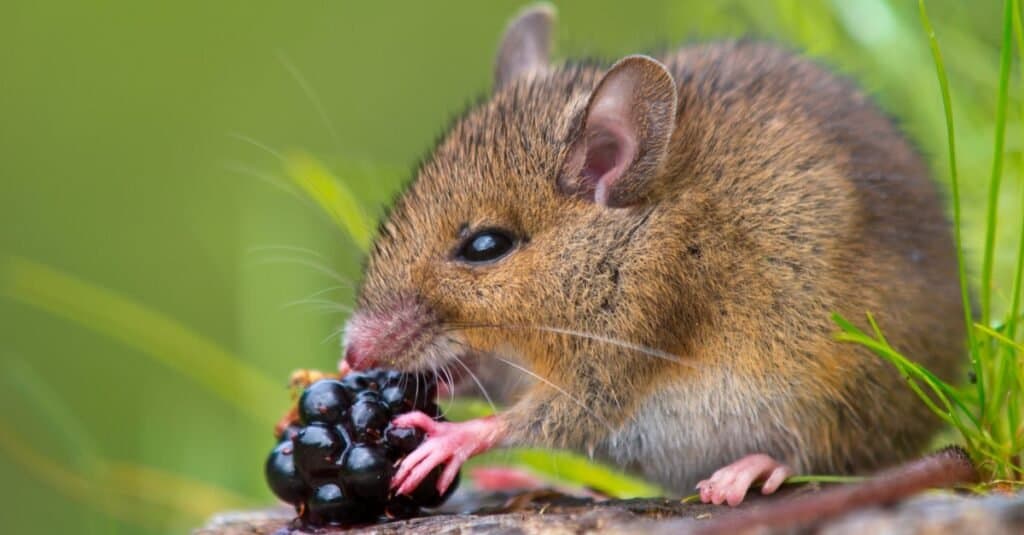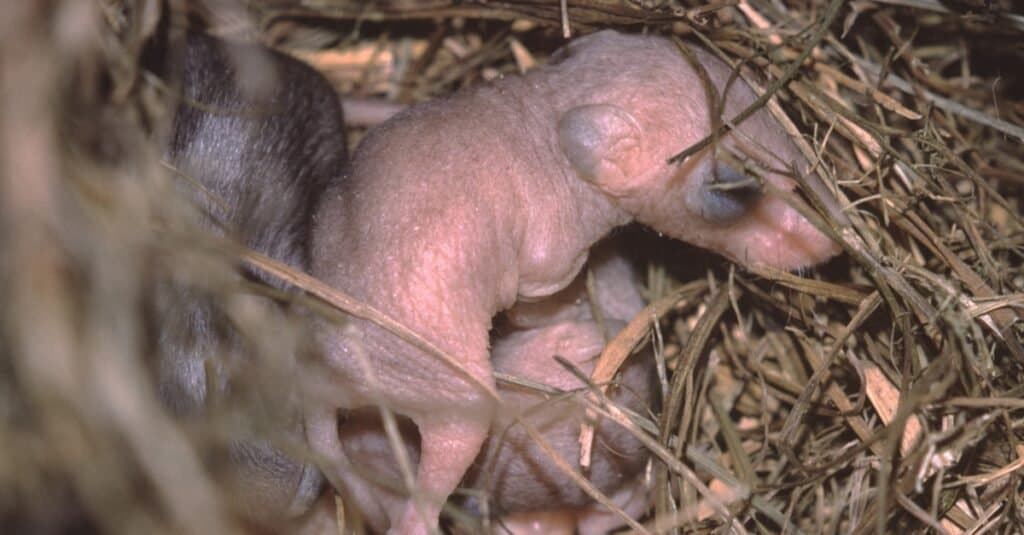The common house mouse (Mus musculus) is one of the most familiar animals on the planet. Mouse gestation periods are short, which means that a couple of mice can quickly turn into many mice. There are dozens of species of mouse, only a few of which make their way into our homes, scientific laboratories, urban areas, and mouse breeding facilities. In fact, mice are part of the Muroid family of rodents, which also includes rats, gerbils, voles, hamsters, and lemmings.
Humans breed mice for various reasons, including as a food source for both humans and pets, and for scientific research. Throughout the world, mice, and their babies, play a bigger role than you might expect in human culture.
Here, we’ll learn all about mice, what they look like, what they eat, and what they act like. Then, we’ll answer the question of just how long a mouse’s gestation period is. We’ll also look at how many babies a mouse can have and what those babies look like. Finally, we’ll find out how many times a year mice can reproduce and which species has the longest gestation.
Mice: The Facts

All mice have small, furry bodies, long, hairless tails, and keen senses of smell.
©Rudmer Zwerver/Shutterstock.com
Mice are small, short-lived, and abundant. They may be brown, white, black, or a mixture of black and white. They’re group animals, who live in intricate nests and burrows. Mice can get pregnant at any time of year, and they have no set breeding season. They’ll eat just about anything they find, including meat and food waste. One female can have over 50 pups in the time it takes a human female to gestate a single baby.
Mice: Appearance and Size
Mice range in size from about 2-4 inches long, not including their tail. They have large, round ears and long whiskers. They’re excellent climbers, and though they may not seem fierce, they come equipped with claws and teeth. At birth, they’re completely hairless and blind. Baby mice (pups) are commonly known as pinkies because of the color of their hairless skin.
Mice: Diet and Behavior

Mice are drawn to food remains of all types.
©Rudmer Zwerver/Shutterstock.com
Mice eat a variety of grains and grasses, and they’re also fond of fruits, vegetables, and nuts. In the wild, mice eat mostly foraged foods, like forbs, nuts, and seeds. In captivity, most owners feed their mice commercial mouse pellets in addition to fresh fruits and vegetables. Because mice are so good at adapting to different settings, urban mice actually eat everything they can find. They’re often drawn to sources of food, like restaurants, accessible garbage, and even home kitchens.
How Many Days are Mice Pregnant?

Mouse gestation length is dependent on the species.
©Jennifer Thornhill/Shutterstock.com
The common house mouse has a gestation period of 19-21 days. Other species of mouse, like the cactus mouse, stay pregnant for 26-28 days. Females go into estrus for 4-5 days per cycle. For those 4-5 days, they’re capable of becoming pregnant. These cycles repeat on a monthly basis, beginning at about six weeks of age. Females go into estrus immediately after giving birth, which means they can become pregnant again directly after birthing a litter of pups.
How Many Babies do Mice Give Birth to?

A single mating pair can lead to over 100,000 new mice in just one year.
©Bosnian/Shutterstock.com
Litter size in mice depends on the quality of available food, the age of the female, and the level of inbreeding in the parent mice. When mice mate with other mice that are closely related to them (like brothers and sisters), the genetic makeup of the offspring is very similar. If this happens generation after generation, the population of mice becomes inbred, which means they’re kind of like clones of one another. In this case, inbreeding can result in smaller litters.
The typical mouse litter size is between 9-12 pups. Inbred populations may have as few as six pups per litter.
What do Baby Mice Look Like?
Because their gestation period is so short, baby mice have a lot of growing still to do once they emerge from the womb. They’re completely dependent on their mother for the first 20 days of life. Within that time, they rely solely on milk. After 20 days, the mother gradually weans them onto solid food.
During their first 20 days of life, baby mice are hairless, blind, and pink. They look like nothing so much as small, pink erasers with legs and tails. As they grow, they slowly develop fur, and their eyes open.
How Many Times Can a Mouse Get Pregnant in a Year?

A female mouse can typically get pregnant within a few days of giving birth.
©Liz Weber/Shutterstock.com
Mice can get pregnant up to ten times per year. Since their gestation period is only 20 days, female mice can produce a new litter around once per month. So, if there’s plenty of food and a safe place to give birth, mouse populations can expand exponentially. Each female mouse can begin reproducing as early as six weeks old and may remain fertile for up to a year.
Which Mouse has the Longest Gestation Period?
Not all mice have a 20-day gestation. In fact, the Cairo spiny mouse stays pregnant for up to 40 days. That’s twice as long as the house mouse’s gestation. Each species of mouse has a slightly different gestation length. The California deer mouse stays pregnant for around 33 days, while the cactus mouse has a gestation period of 27 days.
The photo featured at the top of this post is © Jennifer Thornhill/Shutterstock.com
Thank you for reading! Have some feedback for us? Contact the AZ Animals editorial team.






